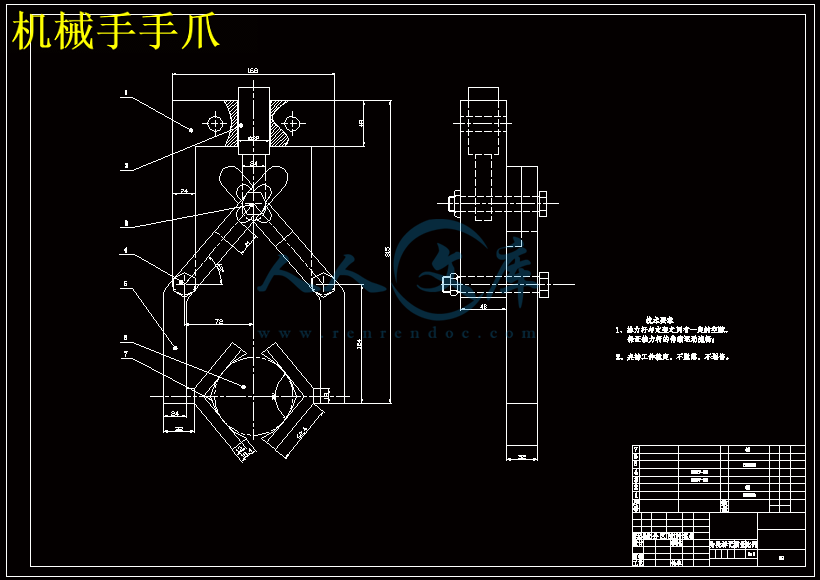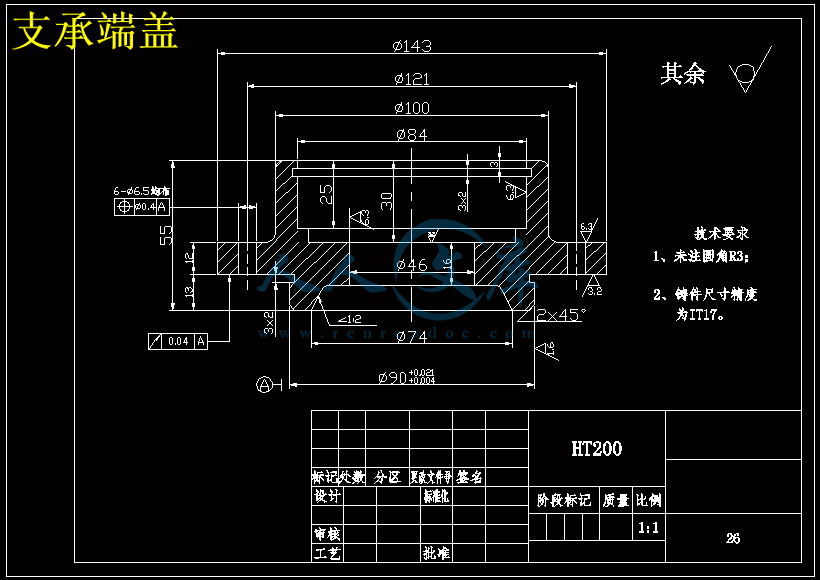摘要
在当今大规模制造业中,企业为提高生产效率,保障产品质量,普遍重视生产过程的自动化程度,工业机器人作为自动化生产线上的重要成员,逐渐被企业所认同并采用。工业机器人的技术水平和应用程度在一定程度上反映了一个国家工业自动化的水平,目前,工业机器人主要承担着焊接、喷涂、搬运以及堆垛等重复性并且劳动强度极大的工作,工作方式一般采取示教再现的方式。
本文将设计一台三自由度的工业机器人,用于给输送产品。首先,本文将设计机器人的机械手爪、手臂、腰部和基座的设计,然后选择合适的传动方式、驱动方式,搭建机器人的结构平台;在此基础上,本文将设计该机器人的驱动控制系统,包括驱动方式和电机的选择、反馈方式和反馈元件的选择、端子板电路的设计以及控制软件的设计,重点加强控制软件的可靠性和机器人运行过程的安全性,最终实现的目标包括:关节的伺服控制和制动问题、实时监测机器人的各个关节的运动情况、机器人的示教编程和在线修改程序、设置参考点和回参考点。
关键词:机器人,示教编程,伺服,制动
INDUSTRIAL ROBOTS
Abstract
In the modern large-scale manufacturing industry, enterprises pay more attention on the automation degree of the production process in order to enhance the
production efficiency, and guarantee the product quality. As an important part of the
automation production line, industrial robots are gradually approved and adopted by
enterprises. The technique level and the application degree of industrial robots reflect the national level of the industrial automation to some extent, currently, industrial robots mainly undertake the jops of welding, spraying, transporting and stowing etc. , which are usually done repeatedly and take high work strength, and most of these robots work in playback way.
In this paper I will design an industrial robot with four dofs, which is used to
carry material for a punch. First I will design the structure of the base, the big arm, the small arm and the end manipulator of the robot, then choose proper drive method and transmission method, building the mechanical structure of the robot. On this foundation, I will design the control system of the robot, including choosing DAQ card, servo control, feedback method and designing electric circuit of the terminal card and control software. Great attention will be paid on the reliability of the control software and the robot safety during running. The aims to realize finally include: servocontrol and brake of the joint, monitoring the movement of each joint in realtime, playback programming and modifying the program online, setting reference point and returning to reference point.
KEY WORDS: robot, playback, servocontrol, brake
目录
1 绪论…………………………………………………………………(1)
1.1工业机器人简介………………………………………………………… (1)
1.2工业机器人的发展……………………………………………………… (3)
1.3课题的提出、意义及主要任务………………………………………… (4)
2 工业机器人的总体设计……………………………………………(5)
2.1工业机器人的组成及各部分关系概述………………………………… (5)
2.1.1执行系统………………………………………………………… (5)
2.1.2驱动系统………………………………………………………… (5)
2.1.3控制系统………………………………………………………… (6)
2.1.4检测系统………………………………………………………… (6)
2.2工业机器人的设计分析………………………………………………… (6)
2.2.1设计要求………………………………………………………… (6)
2.2.2工业机器人主要技术参数……………………………………… (7)
2.3 机器人的运动概述………………………………………………………(7)
2.3.1工业机器人的运动自由度……………………………………… (8)
2.3.2 机器人的工作空间和机械结构类型……………………………(8)
2.3.3 机器人的运动过程分析 ……………………………………… (9)
2.4原理方案的拟定………………………………………………………… (9)
2.4.1原理方案的选择………………………………………………… (9)
2.4.2原理方案的确定…………………………………………………(10)
3 工业机器人机械子系统的设计………………………………… (11)
3.1机械手手爪的设计………………………………………………………(11)
3.1.1设计时要注意的问题……………………………………………(11)
3.1.2总体结构设计……………………………………………………(11)
3.1.3气缸的选择和夹紧力的校验……………………………………(12)
3.1.4弹性爪的强度校验………………………………………………(13)
3.2手臂机构的设计…………………………………………………………(14)
3.2.1手臂的设计要求…………………………………………………(14)
3.2.2手臂机械结构设计………………………………………………(14)
3.2.3伸缩气缸的选择…………………………………………………(15)
3.2.4活塞杆的强度校核………………………………………………(15)
3.3腰部和基座设计…………………………………………………………(17)
3.3.1结构设计…………………………………………………………(17)
3.3.2升降气缸的选择…………………………………………………(18)
3.3.3步进电机的选择 ……………………………………………… (18)
3.3.4连轴器的选择……………………………………………………(21)
3.3.5 轴承的选取………………………………………………………(22)
3.3.6齿轮的选择………………………………………………………(24)
4 工业机器人气动系统的设计…………………………………… (25)
4.1气动系统的概述…………………………………………………………(25)
4.2气动系统的分析与设计…………………………………………………(25)
5 工业机器人运行时应采取的安全措施………………………… (27)
5.1安全要求…………………………………………………………………(27)
5.2实施方法…………………………………………………………………(28)
总结………………………………………………………………… (28)
致谢………………………………………………………………… (29)
参考文献…………………………………………………………… (30)
1绪论
1.1工业机器人简介
在现代工业中,生产过程的机械化、自动化已成为突出的主题。化工等连续性生产过程的自动化已基本得到解决。但在机械工业中,加工、装配等生产是不连续的。专用机床是大批量生产自动化的有效办法;程控机床、数控机床、加工中心等自动化机械是有效地解决多品种小批量生产自动化的重要办法。但除切削加工本身外,还有大量的装卸、搬运、装配等作业,有待于进一步实现机械化。机器人的出现并得到应用,为这些作业的机械化奠定了良好的基础。
“工业机器人”(Industrial Robot):多数是指程序可变(编)的独立的自动抓取、搬运工件、操作工具的装置(国内称作工业机器人或通用机器人)。
机器人是一种具有人体上肢的部分功能,工作程序固定的自动化装置。机器人具有结构简单、成本低廉、维修容易的优势,但功能较少,适应性较差。目前我国常把具有上述特点的机器人称为专用机器人,而把工业机械人称为通用机器人。
简而言之,机器人就是用机器代替人手,把工件由某个地方移向指定的工作位置,或按照工作要求以操纵工件进行加工。
机器人一般分为三类。第一类是不需要人工操作的通用机器人,也即本文所研究的对象。它是一种独立的、不附属于某一主机的装置,可以根据任务的需要编制程序,以完成各项规定操作。它是除具备普通机械的物理性能之外,还具备通用机械、记忆智能的三元机械。第二类是需要人工操作的,称为操作机(Manipulator)。它起源于原子、军事工业,先是通过操作机来完成特定的作业,后来发展到用无线电讯号操作机器人来进行探测月球等。工业中采用的锻造操作机也属于这一范畴。第三类是专业机器人,主要附属于自动机床或自动生产线上,用以解决机床上下料和工件传送。这种机器人在国外通常被称之为“Mechanical Hand”,它是为主机服务的,由主机驱动。除少数外,工作程序一般是固定的,因此是专用的。













 川公网安备: 51019002004831号
川公网安备: 51019002004831号